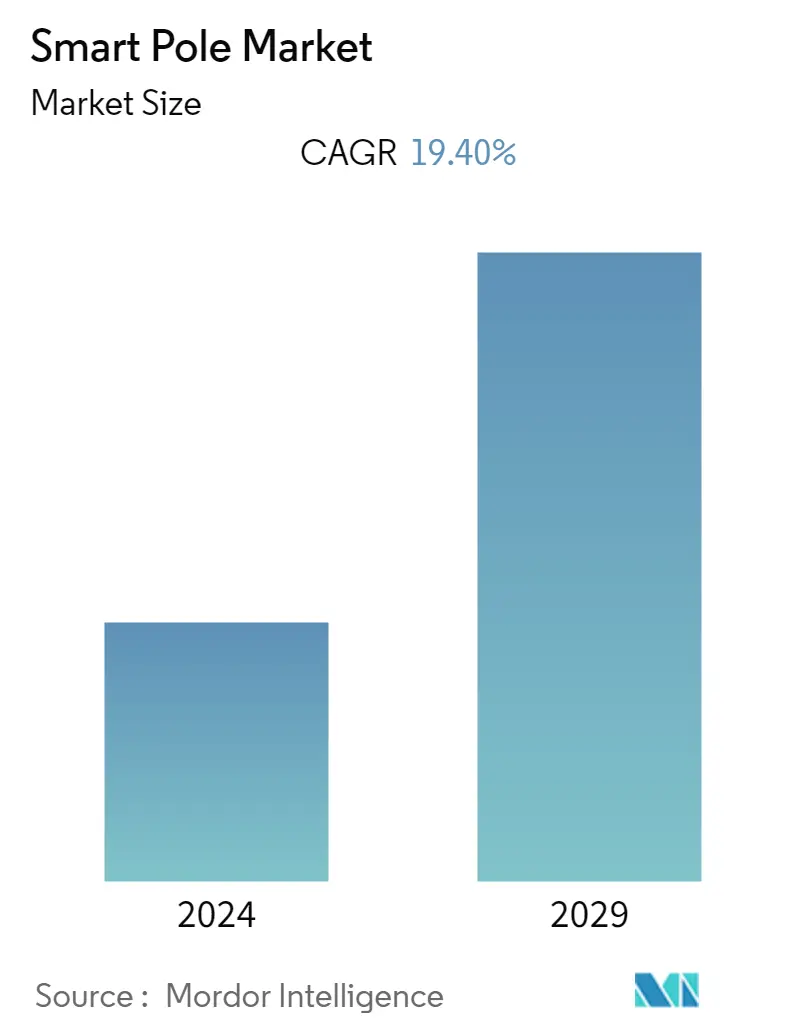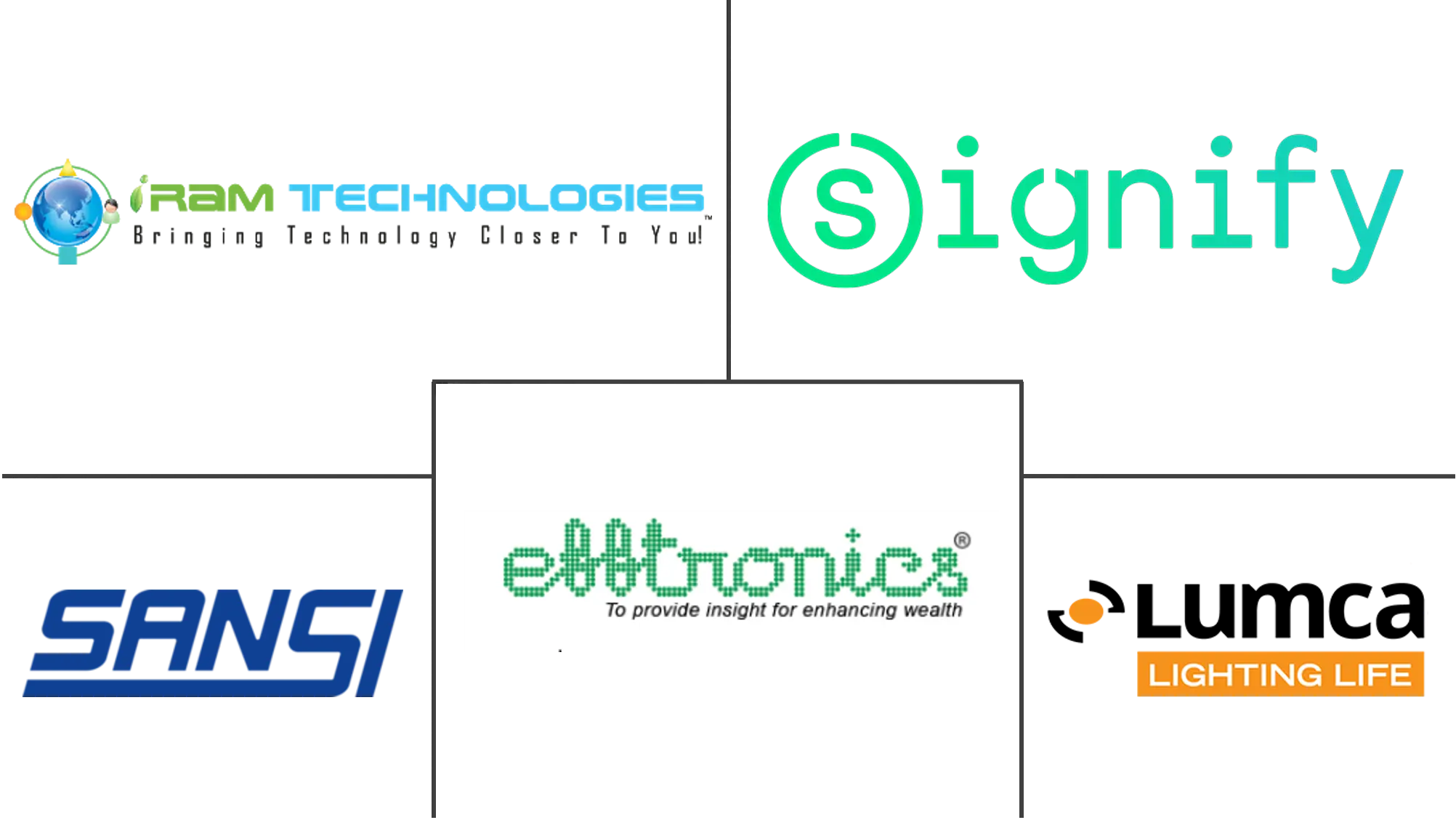Market Size of Smart Pole Industry

| Study Period | 2019 - 2029 |
| Base Year For Estimation | 2023 |
| CAGR | 19.40 % |
| Fastest Growing Market | Asia Pacific |
| Largest Market | North America |
| Market Concentration | Low |
Major Players
*Disclaimer: Major Players sorted in no particular order |
Smart Pole Market Analysis
The smart pole market is expected to register a CAGR of 19.4% during the forecast period. The increasing need for reducing traffic jams and preventing accidents and growing initiatives by various governments for smart cities is expected to drive the market's growth.
- Government programs supporting the development of smart cities and the growing demand for energy-efficient streetlights are expected to aid the growth of the Smart Pole market globally. In addition, the rising need to avert traffic jams and avoid accidents is projected to be a pivotal contributor to adopting smart poles during the study period.
- To capitalize on the existing trend, key players in the market are engaged in developing smart poles with the integration of advanced technology, such as security cameras, traffic management systems, wireless sensor networks, and other facilities. Such new and innovative solutions by the companies in the market are also expected to increase the demand for smart poles globally during the forecast period.
- Moreover, the rising infrastructure for smart city projects and Internet of Things platforms to monitor city infrastructure, manage traffic flows, and parking water and air quality is driving the market growth. The growing urbanization and rising use of personal and public vehicles make the city traffic-congested and push municipalities for better traffic management around the cities.
- Additionally, traffic congestion has been a specifically cited reason for the city's poor quality of life. Thus, to reduce traffic jams and prevent accidents, smart poles are gaining traction in the cities, as they can provide traffic management with the following attributes: traffic monitoring, traffic guidance, vehicle monitoring, and parking guidance.
- According to the Ministry of Road Transport and Highways, Government of India (GOI), approximately 35 to 40% of total accidents occur at traffic junctions. To resolve such a challenge, smart cities look to Mobility-as-a-Service (MaaS) (integration of different forms of transport into a single service, which can be accessed on-demand) solutions to reduce the number of vehicles on the road. Smart poles embedded with cameras can observe road conditions. With constant smart pole traffic monitoring, municipalities with valuable data can help improve traffic flows, guide maintenance decisions, and facilitate emergency crew deployment. Furthermore, tracking data can monetize street traffic for private commercial development and other city planning applications.
- However, the high initial costs of smart poles are challenging the market's growth over the forecast period. The requirement of green energy to run smart poles is a major factor contributing to the high initial cost of installing smart poles. In addition, smart poles require constant maintenance in harsh weather conditions. Due to the high initial costs, government authorities mostly take up smart pole projects.
Smart Pole Industry Segmentation
Smart poles are connected light sources that can be remotely managed. The smart pole technology offers multi-utility functions and facilities for citizens, visitors, and businesses. Smart poles are used in applications, such as highways, roadways, and public places. Smart pole features technology to improve mobile network performance across the city and provide various benefits, such as internet connectivity, public announcement speakers, and charging points, to help citizens in public places.
The study tracks the key market parameters, underlying growth influencers, and major vendors operating in the industry, which supports the market estimations and growth rates over the forecast period. The scope of the report encompasses market sizing and forecast for segmentation by geography. The market sizes and forecasts are provided in terms of value (USD) for the above segments. The study further analyzes the impact of COVID-19 on the ecosystem.
| By Geography | |
| North America | |
| Europe | |
| Asia-Pacific | |
| Rest of the World |
Smart Pole Market Size Summary
The smart pole market is poised for significant growth, driven by the increasing demand for smart city solutions and energy-efficient infrastructure. Governments worldwide are actively promoting smart city initiatives, which include the deployment of smart poles equipped with advanced technologies such as security cameras, traffic management systems, and wireless sensor networks. These innovations are aimed at reducing traffic congestion, enhancing public safety, and improving urban living conditions. The integration of Internet of Things (IoT) platforms further supports the management of city infrastructure, traffic flows, and environmental monitoring, thereby boosting the adoption of smart poles. Despite the high initial costs and maintenance challenges, the market is expected to expand as municipalities seek to improve traffic management and quality of life in urban areas.
The Asia-Pacific region is anticipated to be a key player in the smart pole market, with countries like China, India, Japan, and Australia leading the charge in smart city developments. Significant investments in smart city projects, such as China's National Smart City Program, are driving the demand for smart poles. Additionally, collaborations between private and public sectors, as seen in various projects across India, are expected to further propel market growth. The competitive landscape is marked by the presence of major players like Signify Holding BV and Iram Technologies Pvt. Ltd., who are expanding their market presence through strategic partnerships and acquisitions. These efforts, coupled with the growing urbanization and need for efficient infrastructure management, are set to fuel the smart pole market's expansion in the coming years.
Smart Pole Market Size - Table of Contents
-
1. MARKET DYNAMICS
-
1.1 Market Drivers
-
1.1.1 Increasing Need for Reducing Traffic Jams and Preventing Accidents
-
1.1.2 Growing Initiative by Various Government for Smart Cities
-
-
1.2 Market Challenges
-
1.2.1 Lack of Standardization of Communication Protocols
-
1.2.2 High Initial Cost
-
-
1.3 Market Opportunities
-
1.3.1 IoT-enabled Products, Networked Streetlights, and Inclusion of Data Analytics
-
-
-
2. MARKET SEGMENTATION
-
2.1 By Geography
-
2.1.1 North America
-
2.1.2 Europe
-
2.1.3 Asia-Pacific
-
2.1.4 Rest of the World
-
-
Smart Pole Market Size FAQs
What is the current Smart Pole Market size?
The Smart Pole Market is projected to register a CAGR of 19.40% during the forecast period (2024-2029)
Who are the key players in Smart Pole Market?
Iram Technologies Pvt. Ltd., Signify Holding B.V., Efftronics Systems Pvt. Ltd., Shanghai Sansi Electronic Engineering Co., Ltd. and Lumca Inc. are the major companies operating in the Smart Pole Market.

